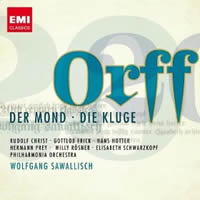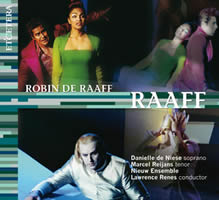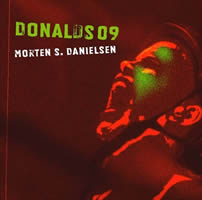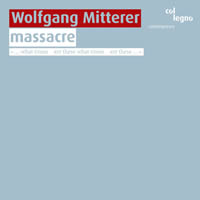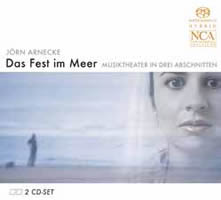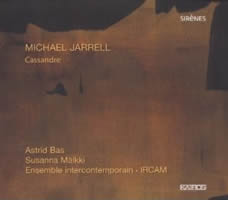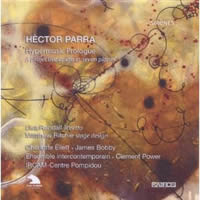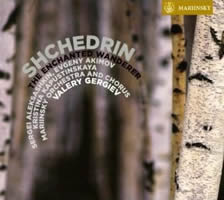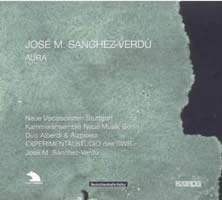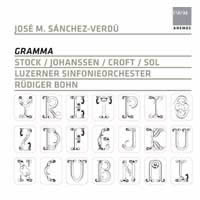Armchair Operas 7.
|
Grant Chu Covell [March 2011.]
Carl ORFF: Der Mond (1939)1; Die Kluge (1943)2. Casts include: Rudolf Christ1, 2, Karl Schmitt-Walter1, Helmut Graml1, Paul Kuén1, 2, Peter Lagger1, Albrecht Peter1, Hans Hotter1, Marcel Cordes2, Gottlob Frick2, Elisabeth Schwarzkopf2, Georg Wieter2, Benno Kusche2, Hermann Prey2, Gustav Neidlinger2. Philharmonia Chorus, Philharmonia Orchestra, Wolfgang Sawallisch (cond.). EMI 50999 6 87638 2 4 (2 CDs) (http://www.emiclassics.com/). We set aside for the moment Orff’s opportunism during the Nazi years. Der Mond appeared two years after the runaway hit Carmina Burana, and like most everything Orff penned in its wake, it shares the same beer-hall bravado, diatonic gamut and hammering rhythms. Particularly striking moments include the moon-snipping motive and the King’s fanfare which opens Die Kluge’s third scene. This EMI double-set dusts off recordings made in 1956 (Die Kluge) and 1957 (Der Mond). Orff provides Die Kluge’s spoken prologue and epilogue. This budget reissue has no librettos. Both casts are impeccable — I wonder what circumstances brought these leading German and Austrian singers to Abbey Road?
Guido MORINI: Una Iliade (2009). Marco Beasley (voice), The Hilliard Ensemble: William Purefoy, Rogers Covey-Crump, Steven Harrold, Gordon Jones, Nederlands Blazers Ensemble. NBELive NBECD024 (1 CD) (http://www.nbe.nl). Distributed in the US by Allegro Music (http://www.allegro-music.com/). Beasley, Moroni and the Netherlands Winds came together elegantly for Una Odissea and join with the Hilliard Ensemble quartet for Una Iliade. Can we now fault Morini for creating something more varied and less chaste than Una Odissea? Much of the same joyous quasi-Baroque dribbles through, except that this time Morini incorporates more dissonance and lingers amongst other popular genres, Monteverdian or jazzy bass lines still featuring prominently, with Il Giudizio di Zeus as the best example. Perhaps I’m being generous — out of context, some numbers could pass for high-school musical camp featuring Rota or Morricone indulging in ethnic whims. Regardless, Beasley’s liquid Italian, a tad less potent, remains a pleasure, and the Netherlands Winds produce exquisitely blended sounds and impeccable harmony. The Hilliard’s tight ensemble adds new-age madrigals.
Kris DEFOORT: House of the Sleeping Beauties (2009). Cast includes: Barbara Hannigan, Omar Ebrahim, Susanne Duwe, Alice Foccroulle, Susanne Hawkins, Els Mondelaers. Asko | Schönberg, Patrick Davin (cond.). Fuga Libera FUG708 (2 CDs) (http://www.fugalibera.com/). Distributed in the US by Allegro Music (http://www.allegro-music.com/). Robin DE RAAFF: Raaff (2004). Cast includes: Marcel Reijans, Danielle de Niese, Mark Tevis, Annett Andriesen, Monique Scholte, David Wilson-Johnson, Paul Rigter. Nieuw Ensemble, Lawrence Renes (cond.). Etcetera KTC 1370 (1 CD) (http://www.etcetera-records.com/). Distributed in the US by Allegro Music (http://www.allegro-music.com/). Unremarkably modernist, Defoort’s House of the Sleeping Beauties tells the creepy story of old men dozing alongside sedated virgins. Spoken dialogues derail the three acts. Perhaps the production’s visuals would have helped flesh out the flat personae. Who would pass on the chance to write an opera about one’s namesake? Raaff’s Raaff updates the friction between tradition and avant-garde that played out during the premiere of Mozart’s Idomeneo. Beyond the robust characterizations, the two acts progress convincingly from day into night and back again. The music makes little impression.
Morten S. DANIELSEN: Donalds09 (2009). Cast and ensemble include: Morten E. Nørskov, Eir Inderhaug, Jens Bruno Hansen, Morten S. Danielsen, Sebastian Eskildsen, Mads Kjølby, Kristen Williams, Allan Von Schenkel, Hélène Navasse, Helene Simonsen, Kasper Hemmer Pihl, Henrik Schmidt. Dacapo 8.226563 (1 CD) (http://www.dacapo-records.dk/). Distributed in the US by Naxos (http://www.naxos.com/). Punk and Classical grapple on the same dingy mattress. Eighteen disorienting numbers slotted into four acts relate Morten E. Nørskov’s story about three unhappy Donalds or perhaps it’s a single Donald with multiple personalities. Danielsen died before the opera achieved its final form, though with the electronics and aggressive processing, it’s hard to imagine that this could go any other way. Are the squeak-toys and distorted voices meant to be clever or merely obnoxious? At just under 75 minutes Donalds09 expires quickly, but its virtuosity and vitality won’t pass unnoticed.
Wolfgang MITTERER: massacre (2003). Cast includes: Elizabeth Calleo, Valérie Philippin, Nora Petročenko, Jean-Paul Bonnevalle, Lionel Peintre. Remix Ensemble, Peter Rundel (cond.). col legno WWE 1CD 20294 (1 CD) (http://www.col-legno.com/). Distributed in the US by Allegro Music (http://www.allegro-music.com/). A nine-person instrumental ensemble plus the composer at the electronics support five singers who take on the royal roles in Christopher Marlowe’s The Massacre at Paris. Mitterer pulverizes an encyclopedia of snippets and gestures during the opera’s three acts. Initially haphazard, as the 73:20 of music unfolds, it’s evident that the unpredictable scattering emphasizes the characters’ instability as they wield power and suffer violence. Abetted by Calleo’s coloratura screeching, brief and distorted quotations fail to reassure.
Jörn ARNECKE: Das Fest im Meer (2003). Cast includes: Maite Beaumont, Renate Spingler, Tomas Möwes, Moritz Gogg, Dieter Weller, Jürgen Sacher. Philharmonisches Staatsorchester Hamburg, Cornelius Meister (cond.). New Classical Adventure NCA 60155-315 (2 SACDs) (http://www.ncamusic.com/). Distributed in the US by Naxos (http://www.naxos.com/). A small ensemble lacking violins deftly supports six singers in this treatment of John Berger’s To the Wedding. Arnecke’s precise harmony, sometimes microtonal, reflects Grisey’s tutelage. NCA captures a live performance that builds with restraint.
Michael JARRELL: Cassandre (1994). Astrid Bas (voice), Ensemble intercontemporain, IRCAM, Susanna Mälkki (cond.). Kairos 0012912KAI (1 CD) (http://www.kairos-music.com/). Distributed in the US by Allegro Music (http://www.allegro-music.com/). Derived from Christa Wolf’s Kassandra, King Priam’s doomed daughter relives the Trojan War. The Ensemble intercontemporain’s crisp projection recalls Boulez; however, Jarrell’s expressionism reaches back to Erwartung. Electronics and synthesizer make clear that this is a modern work. Bas’ tour de force extends across the appealing 53:26.
Hèctor PARRA: Hypermusic Prologue (2008-09). Cast includes: Charlotte Ellett, James Bobby. Ensemble intercontemporain, Clement Power (cond.). Kairos 0013042KAI (2 CDs) (http://www.kairos-music.com/). Distributed in the US by Allegro Music (http://www.allegro-music.com/). This “projective opera in seven planes” frolics with current theories in physics to texts by physicist Lisa Randall. Of course composers may find inspiration anywhere, and so this collaboration isn’t incomprehensible. The eight-person ensemble enhanced with electronics and computer processing skitters across a bubbly post-Lachenmann soundscape with extended vocal techniques. Electronic processing conveys the fifth dimension. There is a brief four-and-a-half-minute electronic interlude worthwhile in its own right. Sung in English, the texts indulge in scientific jargon. Without Parra’s crisp and vivid music this might easily become absurd. Who else but Ensemble intercontemporain and IRCAM could pull this off? The opera fits on one 63:32 CD. An accompanying hour-long disc offers snippets of Randall and Parra discussing physics and the music’s innovations. Kairos’ abundant production cleaves the extensive notes into two booklets, German and English in one, Spanish, French and Catalan in the other.
Rodion SHCHEDRIN: The Enchanted Wanderer (2002); Four Fragments from The Little Humpbacked Horse (1955); Concerto for Orchestra No. 1, “Naughty Limericks” (1963). Cast includes: Sergei Aleksashkin, Kristina Kapustinskaya, Evgeny Akimov. Mariinsky Soloists, Orchestra and Chorus, Valery Gergiev (cond.). Mariinsky MAR0504 (2 SACDs) (http://www.mariinskylabel.com/). Distributed in the US by Harmonia Mundi (http://www.harmoniamundi.com/). Without Gergiev’s advocacy, Shchedrin’s astonishing two-act confection of Russian clichés ought otherwise to fail in the 21st century. Leskov’s tale about a deceived wanderer is sketched in hardened melodies and invented folk tunes à la Balakirev. The Little Humpbacked Horse excerpts alternate Prokofiev’s lyricism with Copland’s prairies. Shchedrin has made a business out of Concertos for Orchestra (Nos. 4 and 5 are on Naxos 8.572405). The First is a scrappy effort. The Mariinsky’s luminescent playing produces astounding balance between strings and winds.
José M. SÁNCHEZ-VERDÚ: Aura (2007-08). Cast includes: Neue Vocalsolisten Stuttgart: Sarah Sun, Truike van der Poel, Andreas Fischer, Martin Nagy, Guillermo Anzorena. Kammerensemble Neue Musik Berlin, Duo Alberdi & Aizpiolea, EXPERIMENTALSTUDIO des SWR, José M. Sánchez-Verdú (cond.). Kairos 0013052KAI (1 CD) (http://www.kairos-music.com/). Distributed in the US by Allegro Music (http://www.allegro-music.com/). José M. SÁNCHEZ-VERDÚ: Gramma (2006). Cast includes: Simone Stock, Daniel Johanssen, Howard Quilla Croft, Tom Sol, Márta Rózsa, Koichi Yoshitomi, Lisandro Abadie, Auke Kempkes. Luzerner Sinfonieorchester, Rüdiger Bohn (cond.). Anemos C33006 (1 CD) (http://www.diverdi.com/anemos/). Distributed in the US by Allegro Music (http://www.allegro-music.com/). Sánchez-Verdú’s fragile universe is ripe with quivering murmuring and subtle sounds. Based upon Carlos Fuentes’ magical-surrealist story, Aura appropriates a mantle worn by Sciarrino and Nono. An accordion duo spins out long ethereal tones. The singers gasp and gesticulate. The instruments are kept sparse and airy. Among the more interesting effects is a low fluttering tuba. Gramma requires larger forces and brings greater variety but is less razor-sharp than the narrowly later Aura. Perhaps this is because Gramma is about how the advent of writing changed man’s reliance upon memory. Be that as it may, Gramma specifies a dramaturgy impossible on a recording: Sánchez-Verdú’s musicians labor upon a platform above the audience. Each listener sits at his own desk, turning pages to follow the plot. Gramma introduces us to Anemos, whose products arrive in little books covered in dust jackets with removable stickers. Listeners may decorate the covers as they see fit.
[More
Arnecke, Danielsen, De Raaff, Defoort, Jarrell, Mitterer, Morini, Parra, Sánchez-Verdú, Shchedrin]
[Previous Article:
Youri Pochtar's late Liszt]
[Next Article:
Bruckner’s Mass No. 2]
|
